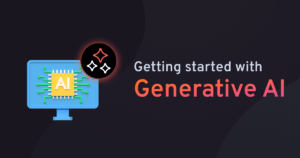Getting started with Generative AI across different enterprise sectors represents a transformative leap in data application, seamlessly infusing advanced artificial intelligence into business processes.
In our relentless pursuit of generative AI use cases across diverse domains—including science, medicine, commerce, entertainment, technology, experimentation, and exploration—we dedicate substantial time and effort to extracting insights that drive informed decision-making. Now, let’s delve into the step-by-step implementation of generative AI in your organization.
Introduction to the Use of Generative AI
Now Artificial intelligence (AI) has changed the way people handle information, enabling decision-makers to scale, implement, and update machine learning (ML) and deep learning models. AI platform tools allow knowledge workers to conduct research, formulate predictions, and execute tasks with growing speed and precision. Large language models (LLMs) are the pivotal catalyst behind this new era.
McKinsey Global Institute estimates that in the manufacturing sector alone, emerging technologies that use AI will by 2025 add as much as USD 3.7 trillion in value. Generative AI makes collaboration available for always-on coding; opens new brainstorming directions and enables credible self-education on any subject.
It can generate human-like responses to interact with customers and colleagues whenever and wherever queried is changing every aspect of a business.

Specifying the Ideal Domain to Use Generative AI
Gaining the benefit of generative AI starts with homing in on the particular domain that can benefit the most from it; take customer service, for example, or patient intake—any area that does not perform at peak efficiency.
To put it another way, in which areas do employees follow standardized routines and established processes? Generative AI is ideal for automating or accelerating these activities, with its ability to synthesize information from various sources and reduce or eliminate manual information entry. Such efficiency frees up employees to focus on higher-value, more creative, or strategic work.
Generative AI can help employees come up with ideas that are outside the box; it can overcome writer’s block and serve as a lively, positive collaborator to bounce ideas off and try out unconventional new concepts. Generative AI can also analyze large amounts of data and generate insights that would be difficult or impossible for humans, such as those locked away in unanalyzed data.
For instance, Generative AI in banking might suggest novel approaches to customer service or risk management. At the same time, Generative AI in HR can aid in developing innovative employee engagement strategies to enhance employee experience.
Evaluating Technical Infrastructure for Getting Started with Generative AI
After identifying the appropriate domain within the enterprise to start implementing generative AI, the next step is to assess organizational readiness. Generative AI calls upon skills, tools, and data governance to ensure a smooth transformation. Define use case value, KPIs, and stakeholders, ensuring alignment of AI initiatives to your unique business objectives.
Is Your Data Infrastructure Ready for Generative AI?
Data must be centralized and optimized for AI applications; a company might have data spread between different back-end systems; pulling in and correlating that data is critical to value. It’s also urgent to prime the enterprise with the right, cleansed data: tools, data governance, and guardrails are crucial.
Companies should make sure that their generative AI is explicable, transparent, and ethical. This is a good time to put guardrails and guiding principles in place. Platforms must track not only the accuracy of results, but also cost, latency, transparency, bias, safety, and prompt monitoring.
Identification & Selection
Identify specific business needs that can be addressed by Generative AI, as well as expected outcomes and how to measure them. Assess your business’s readiness, considering available resources, budget, and technical expertise.
Then, select the appropriate type of Generative AI application for your organization, considering your use case, the type and quality of your data, and the resources needed to train and deploy the model.
For example, utilizing Generative AI in healthcare can transform patient care management. It can interact with healthcare providers, facilitate prescription refills, and provide easy access to test results and medication information, thereby streamlining processes for both staff and patients through cutting-edge AI technology.
Think About Specific Personas
Once you’ve settled on a domain, consider which job functions will make it optimally productive. It’s smart to target job roles that are hard to retain and involve repetitive and dissatisfying tasks. Thus, you can improve employee satisfaction, productivity, and retention when generative AI minimizes drudgery and encourages people to use strategic judgment.
For example, healthcare pre-authorization rituals are costly, and frustrating for patients, and takes hours or even days to obtain authorization for a simple procedure. Generative AI can accelerate such routines, empowering employees to work on fulfilling tasks and streamlining efficiency for customers or patients.

Choosing an Appropriate Generative AI Platform for Implementation
Some AI platforms provide advanced capabilities, such as natural language processing (NLP) or AI voice bots that are equipped with speech recognition. They propel operations, make data-driven decisions, deploy AI applications effectively, and achieve competitive advantages.
Development platforms encourage collaboration between data science and engineering teams. They decrease costs by reducing redundant behavior and automating routine tasks.
Summary of Key Benefits
AI platforms drive a range of benefits for your business, such as increased automation, scale, security, and more. Here are some capabilities:
- Data extraction: Sort through large documents and complex details to quickly pull desired information.
- Content generator: Deep-learning models can create text, images, and other content based on the data they were trained on. Craft marketing emails, create customer personas, and save time.
- Automated classification: Read and classify written input such as customer complaints, while reviewing customer feedback sentiment.
- Summary generator: Transform heavy text into a high-quality summary, capture key points from financial reports, meeting transcriptions, and more.
- Enhanced security: Open-source packages are frequently used by data scientists, application developers, and data engineers, but they can pose a security risk. The best AI platforms typically have various measures in place to ensure the protection of your data, application endpoints, and identity.
Understanding and Mitigating Ethical and Legal Implications
AI governance is about the ethical, responsible, and compliant development and implementation of your AI and ML models. It’s critical to have thoughtful governance capabilities and instill trust and reliance in your decisions. Seek a platform that implements robust governance practices to ensure the standardization of data, the mitigation of bias, and compliance with industry regulations.
Be Aware of Ethical Concerns: Deepfakes, Misinformation, and Bias
The rise of generative AI has brought ethical and societal dilemmas to the forefront. Deepfakes, AI-generated videos that superimpose existing footage with fabricated content can mislead viewers and distort the truth. Misinformation, perpetuated by AI-generated texts or media poses threats to objective reality, further polarizing societies. If training data harbors biases, the generative AI model’s outputs may reinforce stereotypes, leading to skewed and unfair results.
Dealing with bias is a challenge with traditional machine learning systems and a clearly defined data set. But with large foundational models like those used for code, text, or image generation, this training data set might be completely unknown. You need policies or controls in place to detect biased outputs and deal with them in a manner consistent with company policy and any relevant legal requirements.
When it comes to generative AI security, you need to prepare for malicious actors’ use of generative AI systems for cyber and fraud attacks, such as those that use deep fakes for the social engineering of personnel. Confer with your cyber insurance provider to verify that your existing policy covers AI-related breaches.
Generative AI uses significant amounts of electricity. Choose vendors that reduce power consumption and leverage high-quality renewable energy to mitigate the impact on your sustainability goals.
Generative models grow from probabilities, which means they can sometimes rely on inaccurate information or churn out uninformed, nonsensical speculation. In fact AI mistakes are real you should be aware of that possibility. This is known as a “hallucination.” Assess all outputs for accuracy, appropriateness, and actual usefulness before relying on or publicly distributing information.

Piloting Generative AI Projects and Scaling Up
Many enterprises have generative AI pilots for code generation, text generation, or visual design. Choosing can be a challenge—as the wrong system can increase costs and limit the use of other valuable tools. Besides pricing, consider all factors when evaluating the most appropriate AI platform. Gain an understanding of available AI tools and their capabilities to make informed decisions that align with your business objectives.
To establish a pilot, you may take one of three routes:
Off-the-shelf. Use an existing model directly by inputting prompts. For example, ask the model for a software engineer job description or create clever subject lines for marketing emails.
Prompt engineering. Program and connect software to leverage a foundational model. This most common technique allows for the use of public services while protecting IP and leveraging private data for precise, specific, and useful responses. An HR benefits AI chatbot that answers employee questions about company-specific policies is an example.
Custom. Build a whole new foundational model, adding a layer of proprietary data that alters model behavior. While costly, it has the benefit of optimizing flexibility.
Scalability throughout machine learning models is vital, as is quality integration. An AI platform should make available open-source software and libraries. It’s also key to consider deployment and usage strategy for your platform: on-premises or hosted using a cloud platform. For internal team use or external customers too?
To enable your foundation models to get very smart, and very fast, choose one functional domain in your business and experiment in that area. Once you’ve chosen a domain that benefits from generative AI, you can cluster use cases and keep making it smarter. Here is a model applied to customer service:
- First: Give call center agents a generative AI tool with a conversational interface to use when taking phone calls. Agents can simply query the interface for a relevant answer to the customer’s question.
- Second: Aggregate those queries as to which questions are most frequently asked. How do you respond, and how promptly? This moves from answering questions to actually summarizing data.
- Third: Prompt generative AI to compare this summary to website FAQs; ask it to answer any questions not addressed on your website and publish them.
Generative AI thus solves three customer service use cases: answer the question, summarize what’s being asked, and offer an answer. The model gets smarter with every interaction. Generally, AI plays a pivotal role in elevating the customer experience.
Measuring the Impact and ROI of Generative AI
Generative AI journey begins with asking an important question:
How will generative AI contribute to business value? Generative AI provides new and disruptive opportunities to increase revenue, reduce costs, improve productivity, and better manage risk. Shortly, it will become a competitive advantage and differentiator.
When evaluating projects, consider the feasibility, actionability, affordability, anticipated business value, and ultimate return on investment of each generative AI project. Embed ROI measures into every use case and project and established KPIs to keep a pulse on progress.
Generative AI Revenue Opportunities
Product development: Generative AI lets you create new products more quickly.
New revenue channels: Gartner research shows that enterprises with greater levels of AI maturity will gain greater benefits to their revenue.
Cost and productivity opportunities: Generative AI can augment workers’ ability to draft and edit text, images, and other media. It can also summarize, simplify, and classify content; generate, translate, and verify software code; and improve chatbot performance.
Regarding process improvement, generative AI derives real, in-context value from vast stores of content, which until now may have gone largely unexploited. This will change workflows.
- Accuracy
Measure the accuracy of the generative AI model in producing relevant and correct outputs.
- Productivity
Assess the impact of generative AI on the productivity of the target persona or department. This could include metrics like the number of tasks completed per unit of time, response time, or reduction in manual effort required.
- Customer satisfaction
If the generative AI use case involves customer-facing applications, use customer satisfaction surveys or feedback to gauge how well the AI system meets customer needs and expectations. Leveraging generative AI can enhance customer service KPIs in many aspects, including CSAT, MTTR, resolution time, and more.
- Cost Savings
Measure the cost savings achieved through the use of generative AI. Compare the costs of employing the AI system to the expenses of traditional manual processes or outsourcing.
- Turnaround time
Evaluate the time taken for the generative AI model to generate responses or outputs compared to traditional methods.
- Quality of output
Assess the quality of the generative AI outputs against predefined criteria through manual review or automated quality checks.
- Error rate
Quantify the rate at which the generative AI model produces incorrect or undesirable outputs. Minimizing error rates is crucial.
- Business Impact
Identify specific business metrics that are directly impacted by the generative AI use case, such as increased sales, reduced customer complaints, or improved employee retention.
- Training time and cost
Measure the time and resources required to train and fine-tune the generative AI model. Efficient training processes can lead to faster implementation and quicker time-to-value.
- Human-in-the-loop metrics
If human intervention is involved, track metrics related to the effectiveness of human oversight.
- Scalability
Assess how well the generative AI model scales to accommodate increased usage or higher demands.
- Regulatory compliance
For sensitive domains like healthcare or finance, monitor how well the generative AI system adheres to relevant regulatory requirements and data privacy
Getting Started with Generative AI for Enterprises
Generative AI presents transformative opportunities across a range of industries. Aisera’s AI Service Desk enhances employee experiences by integrating Generative AI, revolutionizing your employee support systems. Aisera’s AI customer service solution, featuring AiseraGPT, significantly improves customer service metrics including customer satisfaction (CSAT) while reducing support costs.
The Aisera AIOps solution, leveraging AiseraGPT and Generative AI, proactively prevents outages. It predicts and detects major incidents with automated root cause analysis, utilizing data from ticketing platforms and MELT (Monitoring, Event Logging, and Tracing) from infrastructure, apps, and services. Explore all our Generative AI demos in one place and request a tailored AI demo for your enterprise today!

